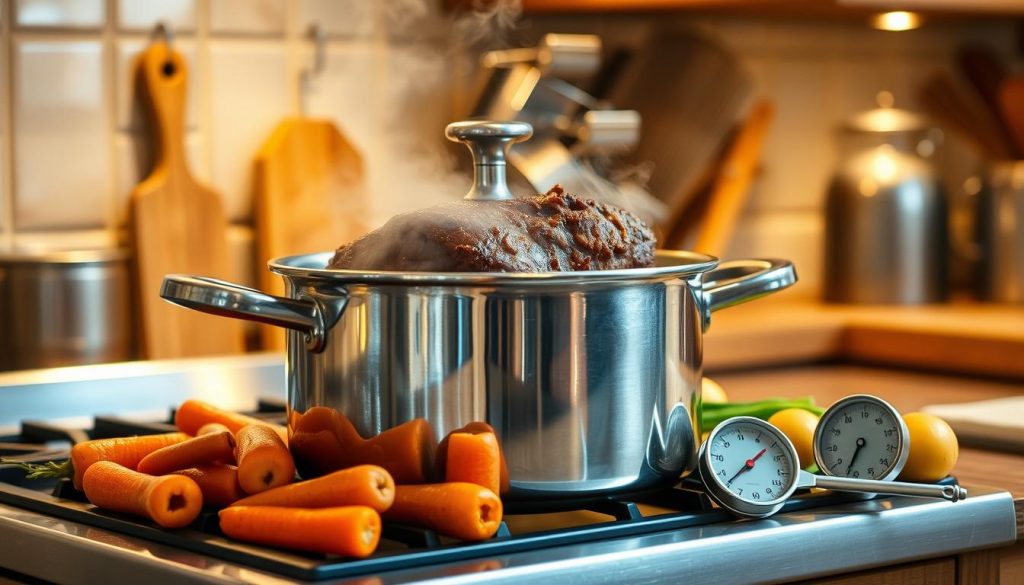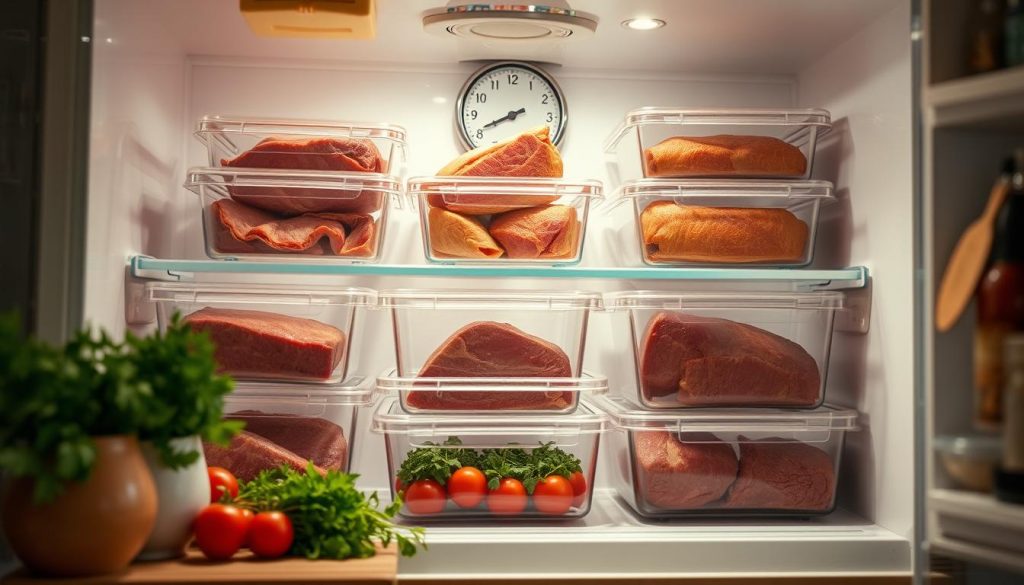Pot roast is a beloved comfort food that often leaves us with tasty leftovers. But how long can we safely keep it in the fridge? Let’s explore food storage and meat preservation to answer this question.
Proper refrigeration is key to maintaining pot roast quality and preventing foodborne illness. Understanding these techniques will help you enjoy your leftovers safely.
Knowing how to store leftovers properly is crucial. Cooked meats like pot roast can last 3 to 4 days in the fridge if stored correctly. This timeframe ensures you can enjoy your meal safely without compromising on taste.
We’ll explore factors affecting pot roast shelf life and share best storage practices. You’ll learn about choosing the right containers and spotting signs of spoilage. Our goal is to keep your pot roast delicious and safe to eat.
Key Takeaways
- Pot roast can be safely stored in the fridge for 3-4 days
- Proper refrigeration is crucial for food safety
- Use airtight containers for optimal storage
- Learn to recognize signs of spoilage
- Follow USDA guidelines for meat storage
- Cool leftovers quickly before refrigerating
- Reheat stored pot roast to 165°F (74°C) for safety
Understanding Pot Roast Storage Basics
Storing pot roast properly prevents spoilage. Let’s explore key factors that keep your pot roast fresh in the fridge. Proper storage ensures safety and maintains flavor.
What Makes Pot Roast Perishable
Pot roast’s high moisture and protein make it perishable. These create an ideal environment for bacteria growth. Without correct storage, meat spoilage can occur quickly.
Ideal Storage Temperature Range
Fridge temperature is crucial for preserving pot roast. Set your fridge between 34°F and 40°F (1°C to 4°C). This range slows bacterial growth, extending leftovers’ shelf life.
| Temperature Range | Effect on Pot Roast |
|---|---|
| Below 34°F (1°C) | May freeze, affecting texture |
| 34°F – 40°F (1°C – 4°C) | Optimal for storage |
| Above 40°F (4°C) | Increased risk of bacterial growth |
The Role of Proper Container Selection
Choosing the right storage container maintains pot roast quality. Airtight containers are best. They prevent air exposure, which can cause faster spoilage.
- Glass containers with tight-fitting lids
- Plastic containers with secure seals
- Vacuum-sealed bags for longer storage
These storage basics help keep pot roast fresh longer. Apply these tips to enjoy safe, delicious leftovers. Your pot roast will stay tasty and safe to eat.
How Long Does Pot Roast Last in the Fridge
Proper storage of leftover pot roast is vital for safety and taste. Let’s explore the shelf life of this delicious dish. Our research provides accurate guidelines for storing your leftovers.
Cooked pot roast can last 3 to 4 days in the fridge when stored correctly. This applies to most cooked meats, including beef, pork, and lamb roasts. Refrigerate promptly after cooking to maximize shelf life.
| Storage Method | Refrigerator (40°F or below) | Freezer (0°F or below) |
|---|---|---|
| Pot Roast (cooked) | 3-4 days | 2-3 months |
| Raw Pot Roast | 3-5 days | 4-12 months |
These timelines are general guidelines. Actual shelf life may vary based on meat quality, preparation, and refrigeration speed. Always use your senses to judge food safety.
“When in doubt, throw it out. It’s better to be safe than sorry when it comes to consuming leftover meats.”
Trust your nose and eyes when checking leftover pot roast. Discard the meat if you notice off-odors, unusual textures, or discoloration. Safety should always come first, even within the recommended storage time.
Signs of Spoiled Pot Roast
Spotting spoiled pot roast is vital for meat safety and preventing food waste. Let’s explore key indicators to determine if your leftover pot roast is safe to eat.
Visual Indicators of Spoilage
Trust your eyes first when checking for bad meat. Look for these warning signs:
- Discoloration (green, gray, or brown spots)
- Mold growth (fuzzy patches)
- Slimy surface
Smell and Texture Changes
Your nose is a powerful tool for identifying food spoilage. Fresh pot roast should have a mild, meaty scent. Discard the meat if you notice these odors:
- Sour or rancid smell
- Ammonia-like odor
- Putrid or rotting scent
Texture changes can also indicate spoilage. If the meat feels slimy or sticky, it’s no longer safe to eat.
When to Trust Your Senses
Your senses are the best judges of meat safety, even with expiration dates. If something seems off, it’s better to throw it out.
Consuming spoiled meat can cause foodborne illnesses. Always prioritize safety over saving leftovers.
| Sense | What to Check | Signs of Spoilage |
|---|---|---|
| Sight | Color, Texture | Discoloration, Mold, Sliminess |
| Smell | Odor | Sour, Rancid, Ammonia-like |
| Touch | Texture | Sticky, Slimy |
Best Practices for Storing Leftover Pot Roast
Preserving leftovers is crucial for enjoying pot roast later. These tips will help keep your meat fresh and tasty. Follow them to make the most of your delicious meal.
Cool your pot roast quickly by dividing it into smaller portions. Then, transfer the meat to airtight containers. This prevents bacterial growth and keeps the flavor intact.
Label containers with storage dates to track freshness. Use the oldest leftovers first. Store your pot roast in the coldest part of your fridge.
“Proper storage is the key to extending the life of your leftover pot roast while maintaining its quality and safety.”
For longer storage, consider freezing. Wrap portions in freezer-safe bags or containers. Remove as much air as possible before sealing.
Frozen pot roast can last up to three months. It will maintain its taste and texture during this time.
| Storage Method | Temperature | Maximum Storage Time |
|---|---|---|
| Refrigeration | 40°F (4°C) or below | 3-4 days |
| Freezing | 0°F (-18°C) or below | 2-3 months |
These storage tips work for most cooked meats. By following them, you’ll become a leftover preservation pro. You’ll also reduce food waste in your kitchen.
Proper Cooling and Packaging Methods
Food cooling techniques are vital for keeping your pot roast safe. Let’s explore the best ways to preserve your leftovers. These methods will help maintain flavor and quality.
Cooling Time Guidelines
Cool your pot roast quickly to stop bacteria growth. Split large portions into smaller containers within two hours of cooking. For faster cooling, use an ice bath and stir occasionally.
Airtight Container Options
Pick the right storage containers for freshness. Glass or BPA-free plastic with tight lids work well. Vacuum-sealed bags are great for longer storage.
Portioning for Better Preservation
Smart meal portioning helps your pot roast last longer. Divide leftovers into single servings before storing. This allows for quicker cooling and easier reheating.
| Container Type | Best For | Storage Duration |
|---|---|---|
| Glass containers | Fridge storage | 3-4 days |
| Plastic containers | Short-term fridge use | 2-3 days |
| Vacuum-sealed bags | Freezer storage | Up to 3 months |
These tips for cooling, packaging, and portioning will extend your pot roast’s life. They’ll help keep its taste and texture intact. Your leftovers will stay delicious for longer.
Reheating Stored Pot Roast Safely
Proper reheating is key to enjoying leftover pot roast safely. We’ll explore the best ways to reheat stored pot roast without compromising taste. Follow these tips to prevent foodborne illness and savor delicious flavors.

The oven method is reliable for reheating pot roast. Preheat to 350°F and place the meat in a covered dish with broth. Heat for about 20 minutes per pound to maintain tenderness and juiciness.
For quicker results, use the microwave. Cut the roast into smaller pieces and place in a microwave-safe dish with liquid. Cover and heat in 30-second intervals, stirring between each, until it reaches 165°F.
“Always use a food thermometer to check that reheated meats reach a safe internal temperature of 165°F to ensure food safety.”
Here’s a handy guide for reheating pot roast using different methods:
| Method | Temperature | Time | Tips |
|---|---|---|---|
| Oven | 350°F | 20 min/lb | Cover and add broth |
| Microwave | High | 30-sec intervals | Cut into smaller pieces |
| Stovetop | Medium-low | 10-15 minutes | Use a covered skillet |
| Slow Cooker | Low | 2-3 hours | Add extra liquid |
Leftover safety is crucial. Don’t leave reheated pot roast at room temperature for over two hours. Follow these guidelines to enjoy tasty leftovers without compromising safety.
Freezing Pot Roast for Extended Storage
Freezing pot roast can extend its shelf life for months. Proper storage techniques ensure you can enjoy this delicious meal later. Let’s look at the best practices for long-term storage of pot roast.
Freezer Storage Timeline
Pot roast can last up to 6 months in the freezer when stored correctly. It’s perfect for meal prep and bulk cooking. For best taste, eat frozen pot roast within 3-4 months.
Proper Freezing Techniques
To maintain the best quality when freezing pot roast:
- Cool the pot roast completely before freezing
- Wrap tightly in plastic wrap or aluminum foil
- Place in a freezer-safe container or bag
- Remove as much air as possible to prevent freezer burn
- Label with the date and contents
Thawing Methods and Safety
Thawing frozen pot roast safely is crucial. Here are the best methods:
- Refrigerator thawing: Place the frozen pot roast in the fridge 24-48 hours before cooking
- Cold water thawing: Submerge the sealed pot roast in cold water, changing the water every 30 minutes
- Microwave thawing: Use the defrost setting, but cook immediately after thawing
Avoid thawing pot roast at room temperature. This can cause bacterial growth and lead to food poisoning.
Food Safety Guidelines for Meat Storage
Proper meat handling is vital for food safety. Let’s look at USDA guidelines for storing pot roast and other meats safely. These tips will help prevent foodborne illnesses and ensure enjoyable meals.
USDA Recommendations
Refrigerate cooked meats within two hours of cooking. In hot environments above 90°F, reduce this time to one hour. Store pot roast in shallow containers for quick, even cooling.
Keep your refrigerator at 40°F or below. This temperature slows down bacterial growth and keeps your meat fresh longer.

Cross-Contamination Prevention
Store raw and cooked meats separately to avoid cross-contamination. Use sealed containers or plastic bags to keep meat juices from dripping onto other foods.
Clean and sanitize surfaces, utensils, and hands after handling raw meat. This practice maintains proper food safety standards in your kitchen.
Temperature Danger Zone Awareness
Bacteria multiply rapidly between 40°F and 140°F, known as the temperature danger zone. Limit the time meat spends in this range during storage and reheating.
Use a food thermometer when reheating your pot roast. Make sure it reaches 165°F for safe consumption.
- Refrigerate pot roast promptly
- Store in airtight containers
- Keep refrigerator temperature at or below 40°F
- Reheat thoroughly to 165°F
Follow these temperature control guidelines and safe meat handling practices. You’ll enjoy your pot roast without worrying about your health.
Common Storage Mistakes to Avoid
Food storage errors can put your pot roast’s safety and quality at risk. Let’s look at common mistakes and how to avoid them.
Overcrowding your fridge is a frequent error. It blocks air flow, causing uneven cooling. Keep space between items and don’t block vents.
Leaving pot roast at room temperature too long is dangerous. Refrigerate leftovers within two hours of cooking. This stops bacteria from growing.
Use shallow, airtight containers for your pot roast. They cool food faster and prevent cross-contamination.
| Common Mistake | Correct Practice |
|---|---|
| Storing hot pot roast directly in the fridge | Cool to room temperature before refrigerating |
| Keeping leftovers for over 4 days | Consume or freeze within 3-4 days |
| Reheating pot roast multiple times | Reheat only once to maintain safety |
Avoid these mistakes to keep your pot roast fresh and safe. Good fridge organization helps maintain food quality. It also prevents foodborne illnesses.
Conclusion
Proper storage is crucial for enjoying pot roast safely. When stored correctly, it stays fresh in the fridge for 3-4 days. Follow these tips to preserve taste and safety.
Cool the pot roast quickly after cooking. Use airtight containers for storage. Keep your fridge at the right temperature. Consider freezing for longer storage.
Learn to spot signs of spoilage. Follow USDA guidelines for food safety. Avoid common storage mistakes and be aware of the temperature danger zone.
These tips will help you enjoy your pot roast leftovers. You can now savor your meal worry-free for days. Happy cooking and safe eating!




